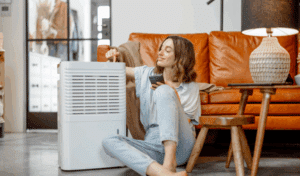Springtime means warmer weather, blooming flowers, and, unfortunately for many, worsening allergies. If you’re constantly sneezing, dealing with itchy eyes, or struggling with congestion, your home’s indoor air quality (IAQ) could be making your symptoms worse. Dust, pollen, mold spores, and pet dander easily accumulate indoors, aggravating allergies and affecting your overall well-being.
But there’s good news: you can significantly improve indoor air quality by implementing a few strategic changes! From routine HVAC maintenance and duct cleaning to investing in air purification systems and humidity control, small improvements can have a huge impact on your home’s air.
Understanding the Importance of Indoor Air Quality
Most people assume that the air inside their home is cleaner than the air outside. However, the Environmental Protection Agency (EPA) states that indoor air can be 2 to 5 times more polluted than outdoor air. This is especially concerning for allergy sufferers, as poor air quality can trigger symptoms and worsen respiratory conditions if left unchecked.
The long-term effects of poor indoor air quality go beyond just sneezing and congestion. Consistent exposure to airborne pollutants can lead to chronic respiratory conditions, fatigue, dizziness, and difficulty concentrating. For individuals with asthma, the presence of mold spores and dust mites can increase the frequency and severity of attacks. Children, older adults, and those with weakened immune systems are particularly vulnerable to the dangers of polluted indoor air.
By improving indoor air quality through residential HVAC solutions, air filtration, and mold prevention, you can create a healthier living space, reduce allergens, and enjoy better respiratory health year-round.
Common Sources of Indoor Allergens
Before tackling any allergy relief tips, you need to know where your allergens come from. A few of the most common sources include:
Dust and Dust Mites
Dust accumulates everywhere—from bookshelves to carpets—and is a major carrier of allergens. Dust mites, which thrive in warm, humid environments, are invisible to the naked eye but are one of the most common indoor allergy triggers. They feed on dead skin cells and hide in bedding, upholstered furniture, and air ducts. Regular vacuuming, dusting, and washing of linens can significantly reduce their presence.
Pollen
Pollen enters homes through open windows, doors, and vents, and it can be carried inside on your clothes, shoes, or by your indoor/outdoor pets. Spring and fall seasons are particularly tough for allergy sufferers as trees, grasses, and weeds release pollen into the air. Once inside, pollen settles on furniture, floors, and HVAC filters, contributing to ongoing allergy issues.
Mold and Mildew
Mold thrives in damp, poorly ventilated areas, such as bathrooms, basements, and HVAC systems. Mold spores can become airborne and trigger allergic reactions, sinus infections, and respiratory issues. A strong musty odor in your home could indicate mold growth, which needs to be addressed immediately.
Pet Dander
Even if you have a hypoallergenic pet, pet dander (tiny skin flakes) can still be a major allergen. Pet fur also traps dust and pollen, making it an indirect contributor to allergy flare-ups. Regularly bathing your pets, cleaning furniture, and using air purifiers can help manage this issue.
Volatile Organic Compounds (VOCs)
VOCs are chemicals found in household cleaners, paints, furniture, and even air fresheners. These compounds contribute to poor indoor air quality and can cause headaches, dizziness, and irritation of the eyes, nose, and throat. Choosing low-VOC or natural cleaning products can help reduce exposure.

Practical Tips to Reduce Indoor Allergens
Regular Professional Cleaning and Maintenance
A clean home is a healthier home, but even daily cleaning routines can miss hidden allergens. Dust, pet dander, and mold can settle into carpets, furniture, and HVAC ducts, making routine professional maintenance essential.
Start by vacuuming carpets and rugs with a HEPA-filtered vacuum at least twice a week. HEPA filters trap microscopic allergens that regular vacuums often miss. Dust furniture with microfiber cloths, which are better at trapping particles than traditional feather dusters. Don’t forget to wash your bedding, curtains, and upholstery in hot water to eliminate dust mites.
Professional duct cleaning and HVAC maintenance should also be scheduled at least once a year. This ensures that dust, mold, and pollen aren’t being circulated through your HVAC system. A clogged system can reduce efficiency and worsen air quality, so keeping it clean is key to an allergy-friendly home.
Ventilation and Air Circulation
Proper ventilation is crucial for reducing stagnant indoor air that traps allergens. Opening windows for even 10–15 minutes a day (when pollen counts are low) can allow fresh air to circulate and replace contaminated indoor air. However, in high-pollen seasons, an Energy Recovery Ventilator (ERV) can help bring in fresh air while filtering out allergens.
Bathrooms and kitchens should have exhaust fans to remove excess moisture, which prevents mold and mildew growth. Ceiling fans can also help improve air circulation, ensuring that air moves freely and doesn’t become stale or stagnant.
Optimal Humidity Control
Excess humidity is one of the biggest contributors to mold, dust mites, and airborne allergens. Keeping humidity levels between 30-50% helps prevent mold growth and aids in allergen reduction.
Using a whole-home dehumidifier is the best way to control moisture levels in humid regions. If you don’t have one, running air conditioners with built-in humidity control or using portable dehumidifiers in damp areas (like basements) can help. Checking for leaks in plumbing, windows, and roofs is also crucial, as hidden moisture problems can contribute to mold growth.
High-Efficiency Air Filters
One of the most effective ways to trap airborne allergens is by upgrading your HVAC system’s air filters. HEPA filters can capture 99.97% of airborne particles, including pollen, pet dander, and dust mites. If you have a standard filter, consider switching to a MERV-13-rated filter or higher for better air quality.
Replacing filters every 2–3 months is crucial to maintaining clean air circulation. For even better protection, consider using standalone air purifiers with HEPA and activated carbon filters in high-traffic areas like bedrooms and living rooms.
HVAC Solutions for Better Indoor Air Quality
Investing in HVAC solutions can take your indoor air quality to the next level. Your heating, ventilation, and air conditioning (HVAC) system plays a key role in filtering allergens, maintaining clean air circulation, and regulating humidity levels. Here’s how professional HVAC services can help:
Air Purification Systems
If you’re struggling with allergies, an air purification system can significantly reduce indoor allergens. These systems work by filtering out airborne pollutants and capturing dust, pollen, mold spores, bacteria, and even viruses. Some of the best air purification solutions include:
- UV-C Air Purifiers – These use ultraviolet light to kill airborne bacteria, viruses, and mold spores before they can circulate through your home.
- Electronic Air Cleaners – These systems use electrostatic attraction to trap even the tiniest airborne particles, such as pet dander and fine dust.
- Activated Carbon Filters – Designed to remove odors and VOCs, these filters help keep indoor air fresh and free from chemical pollutants.
Installing an air purifier that integrates with your HVAC system ensures continuous air filtration throughout your home, helping you breathe cleaner air year-round.
Duct Cleaning and Sealing
Over time, dust, pollen, pet dander, and even mold spores can accumulate in your HVAC ductwork, creating poor air quality and spreading allergens. If you’ve never had your ducts cleaned, allergens could be circulating throughout your home every time your HVAC system runs.
Professional duct cleaning and sealing removes built-up debris, ensuring only clean, filtered air is distributed. Sealing leaks in ductwork can also improve energy efficiency, reduce heating and cooling costs, and prevent contaminants from entering the system.
Routine HVAC Maintenance
A poorly maintained HVAC system can become a breeding ground for allergens. Dust buildup, clogged filters, and mold growth within the unit can lead to poor air circulation and increased allergy symptoms. To prevent this, schedule professional HVAC maintenance at least twice a year—once before summer and again before winter.
Routine maintenance includes:
✔ Inspecting and replacing air filters to ensure efficient allergen removal
✔ Cleaning coils and blower components to prevent mold and bacteria buildup
✔ Checking humidity controls to ensure balanced indoor moisture levels
✔ Sealing duct leaks to prevent the spread of allergens and improve energy efficiency
Regular HVAC maintenance doesn’t just improve indoor air quality—it also extends the life of your system and keeps it running efficiently year-round.
Geothermal Systems and Allergy Relief
If you’re looking for a long-term, energy-efficient solution for heating and cooling, a geothermal HVAC system may be the answer. Unlike traditional furnaces and air conditioners, geothermal systems use the stable temperature of the earth to heat and cool your home more efficiently.
Consistent Temperature and Humidity
One of the key benefits of a geothermal system is its ability to maintain a steady indoor temperature and humidity level. Unlike traditional heating and cooling systems that cycle on and off, geothermal systems provide continuous comfort, reducing temperature fluctuations.
Energy Efficiency Benefits
Geothermal systems are among the most energy-efficient HVAC options available. They consume up to 50% less energy than conventional heating and cooling systems, leading to lower utility bills and a smaller environmental impact. Because they don’t burn fossil fuels or produce combustion byproducts, geothermal HVAC systems help maintain cleaner indoor air and reduce exposure to pollutants and carbon monoxide.
Seasonal Allergy Management
While improving indoor air quality is crucial, seasonal allergies require extra precautions. Managing allergy symptoms effectively involves a combination of home adjustments and awareness of outdoor conditions.
Timing Windows and Doors
During peak allergy season, pollen counts tend to be highest in the morning and late afternoon. To reduce exposure, keep windows and doors closed during these times and use window screens to help block larger airborne particles.
If you enjoy fresh air, consider opening windows briefly in the evening, when pollen levels tend to drop. Running an air purifier indoors can also help filter out any pollen that enters your home.
Monitoring Air Quality Index
Checking the Air Quality Index (AQI) in your area can help you plan your day accordingly. On high-pollen or poor air-quality days:
- Limit time spent outdoors, especially in the morning.
- Wear sunglasses and a hat to keep pollen away from your eyes and hair.
- Shower and change clothes after spending time outside to avoid bringing allergens indoors.
- Use an air purifier with a HEPA filter to minimize indoor exposure.

Why Choose Dynamic Heating Cooling & Geothermal?
At Dynamic Heating Cooling & Geothermal, we specialize in residential HVAC solutions designed to improve indoor air quality and energy efficiency. Our team is here to help whether you need air purification, duct cleaning, humidity control, or a full geothermal system installation.
- Expert duct cleaning and sealing to eliminate allergens
- High-efficiency air purification systems for a healthier home
- Energy-efficient HVAC solutions, including geothermal heating and cooling
- Detailed seasonal maintenance plans for better air quality
With our state-of-the-art Connecticut HVAC services, we help homeowners achieve cleaner, healthier air year-round.
Choose DHC + G for Cleaner Air
Allergy sufferers don’t have to struggle through every season. By making simple changes like upgrading air filters, improving ventilation, investing in a purification system, and maintaining proper humidity, you can significantly reduce allergens in your home.
For those looking for long-term solutions, geothermal HVAC systems, whole-home dehumidifiers, and professional duct cleaning can make a difference. Looking for professional HVAC services in Connecticut? Contact Dynamic Heating Cooling & Geothermal today for expert solutions tailored to your home’s needs!
